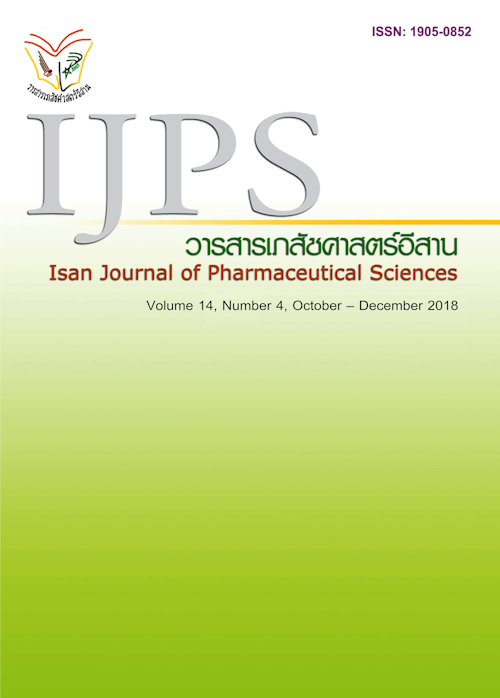Assessment of Adherence to the Practice Guideline of High Alert Drugs for Inpatient Department: Case Study at a Community Hospital in Central Region
Main Article Content
Abstract
High alert drugs (HAD) management is an important safety policy that has been announced by the World Health Organization. In Thailand, the Healthcare Accreditation Institute has provided HAD management as an important standard. This study aimed to assess the adherence to practice guideline and management of drug related problem in HAD group. Methodology: This study was a prospective descriptive observational study. The sample population were 250 prescribing of 10 items of injectable formulation in the high alert drug for inpatient during May 2016 and September 2016. Results: There were 250 prescribing of HADs. There were 80 patients in the study. 51.25 % were men. The mean age was 56.5 years (±19). The most commonly prescribed drugs were 50% magnesium sulfate (50.4%), followed by potassium chloride (20.8%) and dopamine (10.4%). Adherence rates to practice guideline in prescribing, transcribing, dispensing and administrating were 90.3, 99.2, 92.4 and 60.1%, respectively. The activities in each step with adherence rate less than 80 percent included attaching of drug trip card on the medical record (75.6%), writing of order to monitor parameters (72.4%), attaching HAD monitoring record form and recording data in the medical record (71.2%), independent double check before administration (55.2%) and HAD monitoring record form and recording complete data (16.4%). Probable adverse drug reactions from HADs occurred 4 events (1.6%), with amiodarone 1.2% and dopamine 0.4% Conclusion: Adherence rates to practice guideline of HAD in step of prescribing, transcribing and dispensing were 90%. These rates were higher than that in the step of administration (60%). Therefore, there should be measures or incentives to follow the guidelines to prevent harms that may occur to the patient.
Article Details
In the case that some parts are used by others The author must Confirm that obtaining permission to use some of the original authors. And must attach evidence That the permission has been included
References
Chanatepaporn P. Development of High-Alert Drug monitoring system in Srinakarind Hospital. Srinakarind Med J 2015; 30(1): 46-56. (in Thai)
Graham S, Clopp MP, Kostek NE, Crawford B. Implementation of a High-Alert Medication Program. The Permanente Journal. 2008 Spring;12(2): 15-22.
Institute of Medicine. To err is human: Building a safer health system [Online]. 1999 Nov [cited 2015 Apr 15]. Available from: http://www.nap.edu/catalog/9728.html
Intarak S. Collaboration of pharmacists and health care team on the management of High Alert Drug monitoring system for inpatient services at Sarapee Hospital, Chiang Mai Province (master’s thesis). Chiang Mai: Chiang Mai University; 2010: 3. (in Thai)
Khunarkornsiri U, Wichitkosoom W. Effect of using inotropic agent oreder form for High-alert Injectable Drugs Order. Thai Journal of Hospital Pharmacy 2012; 22(1): 33-9.
Krejcie RV, Morgan DW. Determinining sample size for research activities. Educational and Psychological Measurement 1970; 30: 607-10.
Makpiroon S. Development of the system for the administration of High-Alert Drugs for patient safety. Thai Journal of Pharmacy Practice 2013; 5(1): 24-42. (in Thai)
Mookkhan J. High alert drugs monitoring system analysis from seriously incidence report of drug administration error in Kudchum Hospital. Journal of Sakon Nakhon Hospital 2008; 11(3): 50-57. (in Thai)
Panjapiyakul P. National patient safety goal 2007-2008. Nonthaburi: Department of Health Service Support, Ministry of Public Health; 2007: 2-6. (in Thai)
Phapanwattana M. Part 11: High-Alert Medication Manage. In: Phapanwattana M, editors. Safety medication system. Bangkok: Poramatkanpim; 2010: 259-285. (in Thai)
Premabhuti T, Suwannaprom P. Roles of interdisciplinary healthcare team in managing High Alert Drugs and development of pictograms for Methylxanthines. Thai Journal of Pharmacy Practice 2013; 5(2): 79-90. (in Thai)
Supphachutikul A, editor. Patient Safety Goals : SIMPLE. 3rd ed. Nonthaburi: Poramatkanpim; 2009.
The Joint Commission on Accreditation of Healthcare Organizations. Medication Error Prevention –Potassium Chloride. Sentinel Event Alert [Online]. 1998 Feb 27 [cited 2015 Apr 13]. Available from: http://www.jointcommission.org/SentinelEvents/SentinelEventAlert/sea_1.htm
Weerakitti S, Chumjam B, Warapasakul C. Nursing system development for risk of medication errors protocol on participation of nursing model for prevention medication error rate. Journal of nurses association of Thailand, North-Eastern division 2013; 31(2): 25-35. (in Thai)


